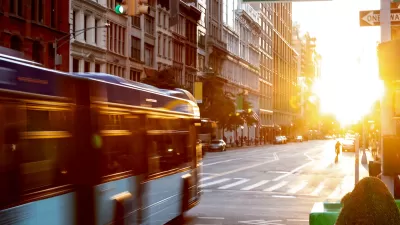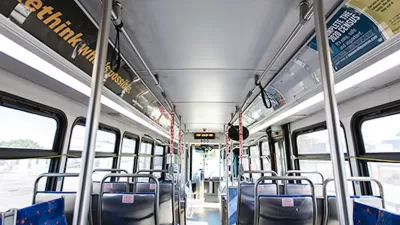Operator shortages are causing transit agencies to cut service unpredictably, leaving riders waiting for ‘ghost buses.’

A blog post from Transit Center explains the phenomenon of “ghost buses,” buses that appear on smartphone apps as minutes away only to never materialize at the station.
“What’s behind this alarming rise in ghost buses? Amid a national shortfall of transit operators, years in the making and worsened by the pandemic, there simply aren’t enough bus operators to run all the trips that transit agencies schedule.” In Los Angeles, the county’s transit agency canceled 1 in 6 trips in January of this year due to a shortage of 600 operators.
There are technical challenges to tracking ghost buses, for riders and agencies alike. Transponders aboard en-route buses share their locations via GPS, feeding real-time arrival boards and trip-planning apps. Canceled trips don’t generate GPS locations, so apps reference and display scheduled arrival data instead. This misleads riders into thinking their bus is running when it’s not.
The blog post recommends that transit agencies begin by tracking and publishing canceled buses to provide more transparency and identify solutions. “Agencies also need to be realistic about the amount of service they can provide with the labor force they have, and adjust schedules accordingly.”
The root of the problem, the blog post cautions, is the structural problems leading to the operator shortage. Transit agencies “must radically improve the job for operators by raising pay and improving working conditions. They must also attract new operators by offering signing bonuses and addressing roadblocks to starting the job, like long waits to receive commercial drivers’ licenses and unnecessarily strict drug testing.”
FULL STORY: Ghost Buses are Haunting Riders Across America

Alabama: Trump Terminates Settlements for Black Communities Harmed By Raw Sewage
Trump deemed the landmark civil rights agreement “illegal DEI and environmental justice policy.”

Planetizen Federal Action Tracker
A weekly monitor of how Trump’s orders and actions are impacting planners and planning in America.

The 120 Year Old Tiny Home Villages That Sheltered San Francisco’s Earthquake Refugees
More than a century ago, San Francisco mobilized to house thousands of residents displaced by the 1906 earthquake. Could their strategy offer a model for the present?

In Both Crashes and Crime, Public Transportation is Far Safer than Driving
Contrary to popular assumptions, public transportation has far lower crash and crime rates than automobile travel. For safer communities, improve and encourage transit travel.

Report: Zoning Reforms Should Complement Nashville’s Ambitious Transit Plan
Without reform, restrictive zoning codes will limit the impact of the city’s planned transit expansion and could exclude some of the residents who depend on transit the most.

Judge Orders Release of Frozen IRA, IIJA Funding
The decision is a victory for environmental groups who charged that freezing funds for critical infrastructure and disaster response programs caused “real and irreparable harm” to communities.
Urban Design for Planners 1: Software Tools
This six-course series explores essential urban design concepts using open source software and equips planners with the tools they need to participate fully in the urban design process.
Planning for Universal Design
Learn the tools for implementing Universal Design in planning regulations.
Clanton & Associates, Inc.
Jessamine County Fiscal Court
Institute for Housing and Urban Development Studies (IHS)
City of Grandview
Harvard GSD Executive Education
Toledo-Lucas County Plan Commissions
Salt Lake City
NYU Wagner Graduate School of Public Service





























